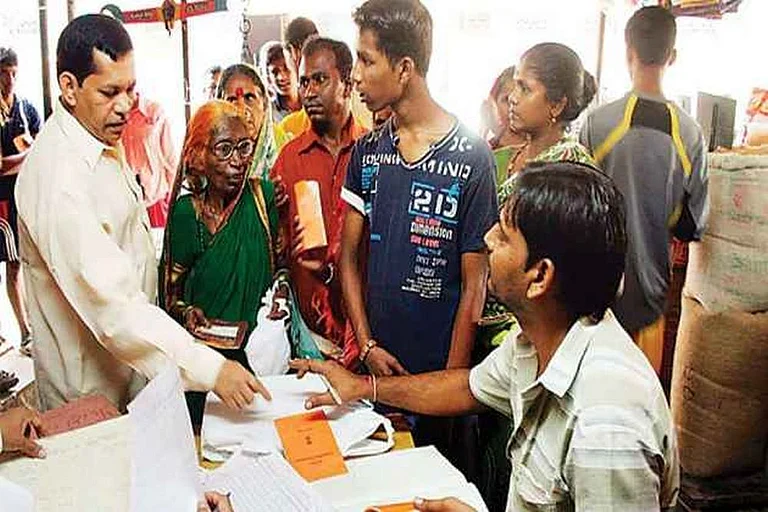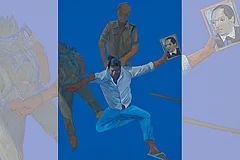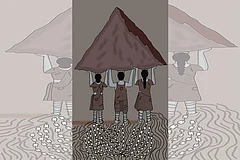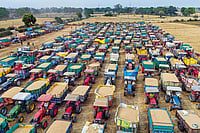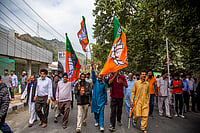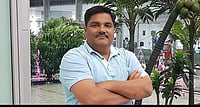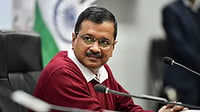Hunger enters Phuli’s doorless home atop a hill in Rajasthan’s Udaipur district and fills up the bellies of nine children who have known hunger more intimately than rice. Their one-room refuge in Umariya village, built with stone boulders and covered with a patchwork of straw, reed and tarpaulin, has little space for them to sleep or to breathe. But hunger trumps all other woes. “Two meals a day feel like a celebration for us,” she says, cradling her youngest child, a skeletal figure in torn clothes. The only dream the 35-year-old chases, unsuccessfully on many days, is to feed all nine kids, including the three abandoned by her sister-in-law who lost her husband.
Phuli’s husband, Masru, 38, is a sharecropper in neighbouring Gujarat, where he tills the fields for one-sixth of the yield. On his days off, he works at construction sites, earning Rs 3,000-4,000 per month. He returned home in February with two quintals of wheat. Phuli says she had to mortgage her belongings to feed the family of 11. They eat less to make their foodgrain stock last until the next harvest. Also, in emergencies, such as if someone falls ill, portions of the same grain are sold to pay the bills. Their diet is meagre, often supplemented with foraged wild vegetables, grasses, and mushrooms. According to the People’s Union for Civil Liberties (PUCL), reliance on foraged food led to 20 deaths, including 12 children, in Baran district within a month in 2002.

Phuli’s village has no electricity or proper road. The nearest government hospital is about 22 km away, while the local Primary Health Centre allegedly relies entirely on the services of a lone Auxiliary Nurse and Midwife. The family has a Below Poverty Line card, but is not enrolled in the National Food Security Scheme (NFSS) that would provide them with free ration. To become beneficiaries, they must register on the Rajasthan Food Security Portal through the E-Mitra service, which costs Rs 150 per applicant. “We couldn’t afford it,” Phuli says.
In all of Kotra block, comprising 66 panchayats, there is just one centre with a biometric machine for free Jan Aadhaar applications. The queues and the waiting are too long for this card that provides identity and address verification, enabling direct transfers of cash benefits to beneficiaries’ bank accounts, and facilitating access to public welfare programmes, e-commerce and insurance services in rural areas. Due to lack of an Aadhaar card, Phuli’s eldest son, 11, has been denied access to basic education. “We are merely surviving and don’t even know if we will make it to tomorrow,” says Phuli.
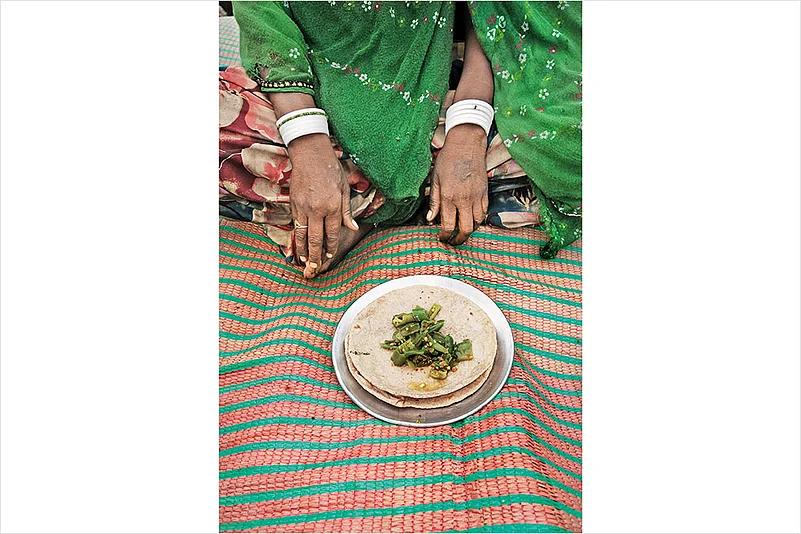
In Padar Phala village, Reshmi Bai, 56, a widow living with three grandchildren is able to survive thanks to the Mahatma Gandhi National Rural Employment Guarantee Act (MGNREGA). However, instead of the government-mandated rate of Rs 251 per day, she says she received Rs 160-170. Her family often goes without two full meals. The biometric scanning machine stopped recognising her fingerprint and retina. The PDS dealer told her to submit several documents, but the issue wasn’t fixed. Her name appears to have either been removed from the records or was never linked properly.
Phuli and Reshmi Bai’s stories highlight the systemic issues that perpetuate poverty, from lack of access to basic services like education and healthcare to corruption and bureaucratic barriers in accessing government programmes. The tale of deprivation extends far beyond Rajasthan; it weaves through every corner of the country, touching countless lives across its vast expanse.
In the dusty landscape of Shankardih Tola in Karma village of Jharkhand’s Bokaro district lived Bhukhal Ghasi, a labourer with a heart as big as his struggles. At 50, his days were filled with toil, planting paddy and digging soil to sustain his family. Despite working tirelessly, Bhukhal couldn’t provide two meals for his family of seven.
Living in abject poverty, they lacked basic amenities and even a ration card, making access to food a daily struggle. Bhukhal died on March 6, 2020, allegedly due to starvation. Weakened by malnutrition, a son and a daughter, too, died within months. Widow Rekha Devi was given a ration card and a hand pump, but unreliable ration supplies and a broken PDS leave them with only rice and lentils, a woefully inadequate diet. “When he passed away from hunger, we could not cook for days and everyone, including the children, went hungry,” recalls Rekha Devi, who was left to navigate the aftermath. “PDS rice is never enough. We often borrow rice at 100 per cent interest. We eat it with salt or just water. It has been four years since we last had bread. We only got help after losing so much.”
Her daughter-in-law, Rita Devi, 24, says, “In our village, work is so scarce we couldn’t even buy groceries or cook proper meals. We only find jobs during July-August; otherwise, we must go outside to earn Rs 250-300 a day.” As her father-in-law’s health declined, he could no longer work. “We borrowed money from others, and there were times when we went to bed without food,” she recounts.
The government initially denied starvation as the cause of Bhukhal’s death, but investigations revealed systemic failure to address hunger. “The struggle for food eventually claimed Bhukhal’s life,” says Rekha Devi. That struggle encompasses the country.
Right to Food: A Fundamental Right
The National Human Rights Commission holds the Right to Food as essential to living with dignity. It says Article 21 of the Constitution of India, which guarantees the fundamental right to life and personal liberty, should be interpreted alongside Articles 39(a) and 47 to fully understand the State’s obligations for ensuring this right. Article 39(a) of the Constitution, a Directive Principle fundamental to governance, mandates that the State should implement policies to ensure all citizens have access to an adequate means of livelihood. Article 47 also outlines the State’s duty to improve the nutrition and standard of living of people as a primary responsibility. Consequently, the Constitution designates the Right to Food as a guaranteed fundamental right, enforceable through the constitutional remedy provided by Article 32.
Living in abject poverty, bhukal’s family lacked basic amenities and a ration card, making access to food a daily struggle. He died on March 6, 2020, allegedly due to starvation.
In the landmark case ‘PUCL versus Union of India and others (2001)’, the Supreme Court of India too affirmed that the right to food is integral to the fundamental right to life under Article 21 of the Constitution. However, despite this legal backing, its implementation often falls short due to various excuses and obstacles.
Data Gaps Fuel Malnutrition Crisis
“When Jharkhand was part of Bihar,” says Balram, Right to Food Campaign activist, “hunger was prevalent in Palamu and gradually spread across the state, affecting districts like Ranchi, Dhanbad and Bokaro. Hunger results from inadequate or unhygienic food, leading to severe health issues and sometimes death.” The PDS, he says, provides only 5 kg of food grains per person per month, which provides 1,500-1,600 calories daily even though a person needs 2,400 (14 kg of grains per month). Lack of basic facilities such as anganwadis and schools worsens the situation. Hunger-related deaths are often misreported as postmortems can detect starvation only if there is no trace of food at all, and desperation can lead to consuming harmful food. Minimal oil usage in these areas causes protein and fat deficiencies. Corruption in the PDS results in reduced rations, and technological solutions like Aadhaar and E-PoS, meant to reduce corruption, have worsened the issue.
According to National Family Health Survey-5, nearly 40 per cent children under the age of five in the state suffer from chronic malnutrition, approximately 39 per cent are underweight, and 22 per cent suffer from wasting. The state suffers from severe malnutrition, with high rates of underweight children (42.9%) and anemia among pregnant women (62.6%). Between 2015 and 2020, 99 starvation deaths occurred across nine states, with Jharkhand accounting for 33.
Nesar Ahmad, director, the Budget Analysis and Research Centre Trust (BARC), Jaipur, contends that the introduction of technology, such as Aadhaar seeding, was intended to ensure welfare benefits reach deserving individuals while excluding ineligible ones. “It may be having the opposite effect. In rural areas, where resources, education and technological infrastructure are limited, instead of facilitating access to essential welfare schemes, technology is inadvertently barring many rightful beneficiaries from receiving the support they need,” he argues.
India faces major challenges in addressing hunger and malnutrition. It leads the world in childhood wasting and low birth.
He describes that the National Food Security Act (NFSA), which came into force in 2013, relied on the 2011 census data. As the figures were not updated regularly, the legislation now fails to address current needs. “Had the Centre updated these figures, the state governments would have issued new ration cards as needed. Instead, the number of beneficiaries allocated to each state has remained static. This rigidity prevents states from addressing new applications for ration cards, exacerbating errors and exclusions in the PDS,” concludes Ahmad.
The PDS designed to assist the poorest during the COVID-19 pandemic fails to reach over 100 million people. According to experts Jean Drèze, Meghana Mungikar and Reetika Khera, this issue stems from the central government relying on outdated 2011 census data for calculating state-wise PDS coverage.
Under the NFSA, the PDS should cover 75% of rural and 50% of urban populations, totalling 67% nationwide. However, because the coverage figures are based on old data, states like Jharkhand, which was meant to have high coverage, now face significant exclusion errors. For instance, Jharkhand has approximately 7 lakh pending ration card applications. The experts are of the view that updating population figures would allow state governments to issue more ration cards and better align with current needs.
India, despite being the world’s second-largest food producer by calorie content, ranked 111th out of 125 countries in the 2023 Global Hunger Index (GHI), which described the country’s hunger levels as “serious”. The GHI is a tool for measuring and tracking hunger. With a population of 1.4 billion, the country houses a quarter of the world’s undernourished individuals, amounting to over 190 million people.
India’s GHI score of 28.7 places it behind countries such as Pakistan (102nd), Bangladesh (81st), Nepal (69th) and Sri Lanka (60th). However, the Ministry of Women and Child Development has criticised the rankings as “flawed” and not reflective of the true situation.
The report, released by Irish NGO Concern Worldwide and German NGO Welthungerhilfe, highlighted India’s child wasting rate (low weight for height) at 18.7%, the highest globally, indicating severe undernutrition. India’s undernourishment rate stands at 16.6%, and its under-five mortality rate is 3.1%. The prevalence of stunting (low height for age) in this age group is 31.7%.
Significant Challenges
India faces significant challenges in addressing hunger and malnutrition. It leads the world in childhood wasting and low birth weight, and ranks first in South Asia for anaemia among women. According to the ‘State of Food Security and Nutrition in the World’ (SOFI) report released on July 24, 2024, India is home to 194.6 million undernourished individuals, the highest number globally. More than half of the Indian population cannot afford a healthy diet. As per Drishti’s 2022 report, around 4,500 children under five die daily in India due to hunger and malnutrition, totalling over 300,000 deaths annually. In comparison, the Planning Commission reported in 2011 that 2,500 children died each year from malnutrition, primarily due to poverty, prompting the Supreme Court to express concern. From 1990 to 2017, the proportion of under-five deaths attributable to malnutrition changed only slightly, from 70.4% to 68.2%.
MORE FROM THIS ISSUE
Poverty in India stems from a mix of historical, economic, social and political factors. The 2023 Multidimensional Poverty Index Report reveals that South Asia, home to about 389 million people, accounts for over a third of the world’s poor, with India contributing nearly 70% to the rise in extreme poverty. According to the World Bank, extreme poverty is defined as living on less than $2.15 per day, with $3.65 representing the lower-middle income threshold. India’s share accounts for 40% of the recent global poverty rate increase, which rose from 23.6% to 24.1%.








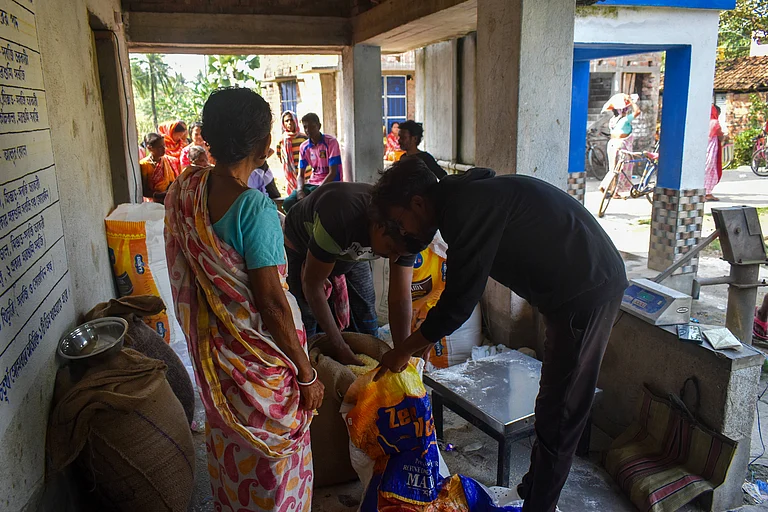
.png?auto=format%2Ccompress&fit=max&format=webp&w=768&dpr=1.0)
